In order to allure hummingbirds, it is crucial to discover plants that can thrive and flourish under your specific weather conditions. If the climate is excessively hot or frigidly cold, the plants may perish or fail to produce enough flowers to provide nectar for the hummingbirds.
The United States is divided into 13 zones based on the average minimum temperature, as indicated by the USDA plant hardiness zone map. Additionally, within each state, there are varying zones. Different plants thrive in different zones, being able to withstand the minimum temperatures but unable to survive in excessively cold conditions.
Louisiana experiences mild winters that remain above freezing and long, sweltering summers. It falls within zones 8 to 10, with southern Louisiana, along the Gulf Coast, enjoying the warmest winters.
However, some plants may also struggle under scorching conditions. To address this concern, the American Horticultural Society introduced the plant heat-zone map, which showcases the average number of days an area experiences temperatures surpassing 86 degrees Fahrenheit.
Louisiana witnesses numerous scorching days, impacting the plant selection suitable for attracting hummingbirds. The majority of Louisiana falls within plant heat zone 9, with certain coastal and northern areas falling into zone 8.
All the recommended hummingbird plants in Louisiana have been thoroughly evaluated in terms of cold and heat zones to guarantee not only their possession of stunning, nectar-rich flowers cherished by hummingbirds but also their ability to thrive in Louisiana’s weather conditions.
The primary challenge for plants in Louisiana is enduring the heat of the summer. Therefore, these hummingbird plants have been carefully selected to withstand the summer heat.
It is highly encouraged to plant as many of these flowers as possible to attract hummingbirds in Louisiana.
Hummingbird Plants for Louisiana in Heat Zones 9 or 8:
1. Trailing Edible Flowers – Nasturtiums
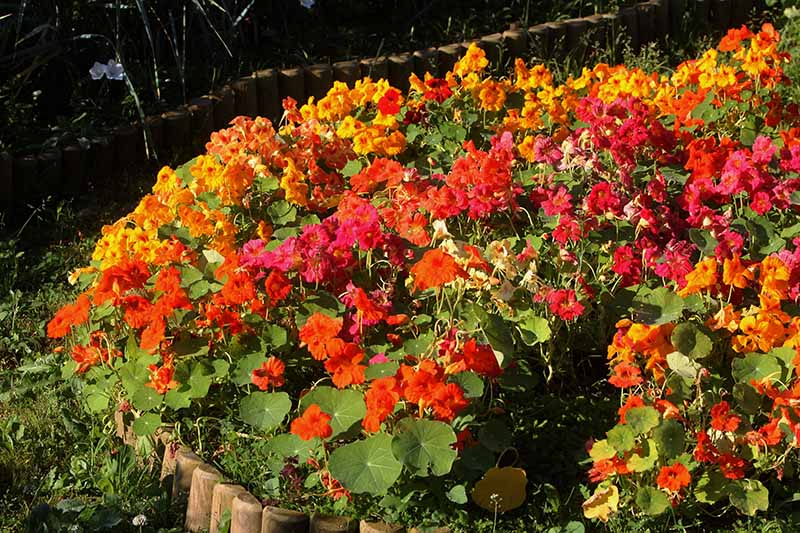
Nasturtiums, with their deep, specially designed flowers and rich nectar, make excellent choices for creating hanging baskets that entice hummingbirds. They come in trailing or bush varieties and are typically grown as annuals. Plant the seeds outdoors shortly after the last frost, ensuring they receive adequate watering during the growing season and regular deadheading.
Common Name: Nasturtiums
Scientific Name: Tropaeolum
Growing Zones: 2 – 11
Sun: Full sun
Soil: Well-drained
Colors: Red, orange, yellow, pink
Height: 1 – 10 feet
Spread: 1 – 3 feet
Plant Type: Annual
2. Flowering Shrubs – Zinnia
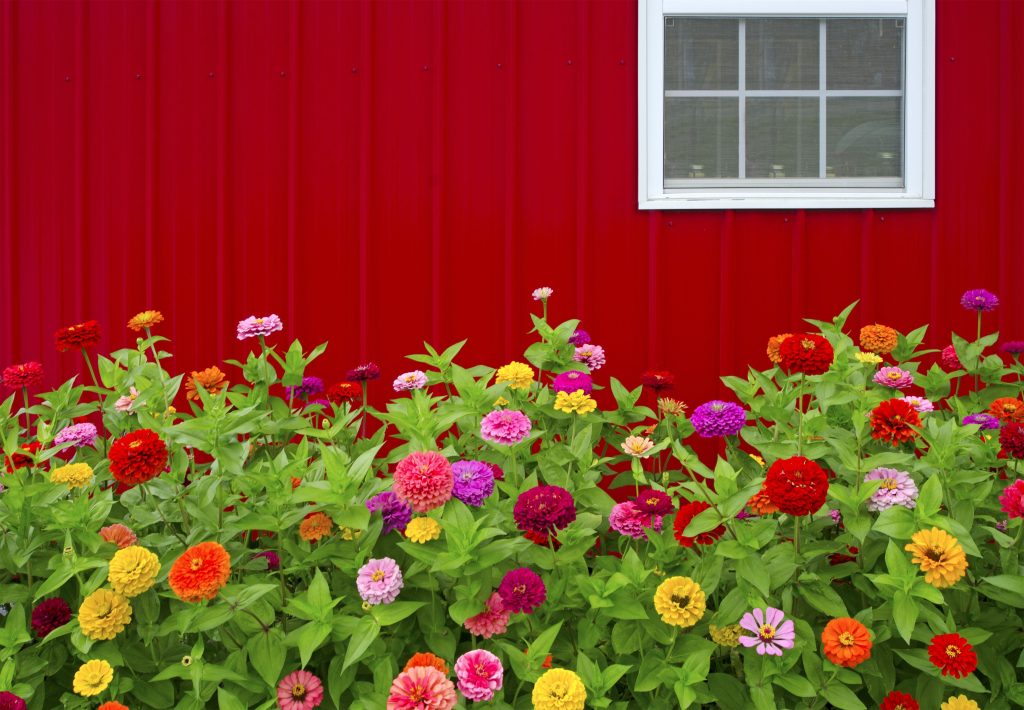
Zinnias are shrubs that produce beautiful flowers and are native to the dry grasslands and scrub of North America. Belonging to the sunflower tribe (Heliantheae) within the Asteraceae family, they come in three main types based on their petal structure. Single-flowered zinnias have a solitary row of petals with a visible center, while double-flowered zinnias possess multiple rows of petals without a discernible center. Semi-double-flowered zinnias showcase numerous rows with visible centers.
Zinnia elegans, known for its tall stems and vibrant colors, is considered a classic choice and is particularly popular for gardens and backyards. Reaching a height of 4 feet, it produces numerous brightly colored flowers and blooms from early summer to frost, attracting pollinators like butterflies and hummingbirds. Growing zinnias is relatively easy; however, they prefer to be planted directly in the desired location, as they do not tolerate transplantation well. Once established in full sun and well-draining soil, these zinnias will provide delightful blooms for an extended period.
Common Name: Zinnea, Zinnia
Scientific Name : Zinnia elegans
Growing Zones: Annuals in 2-8, Perennials in 9-11
Sun: Full sun
Soil: Neutral to slightly alkaline, well-draining
Colors: White, yellow, orange, pink, red, purple
Height: 1 – 4 feet tall
Spread: 12 – 18 feet wide
Plant Type: Annual, Perennial Shrubs
3. Aromatic Perennials – Agastache
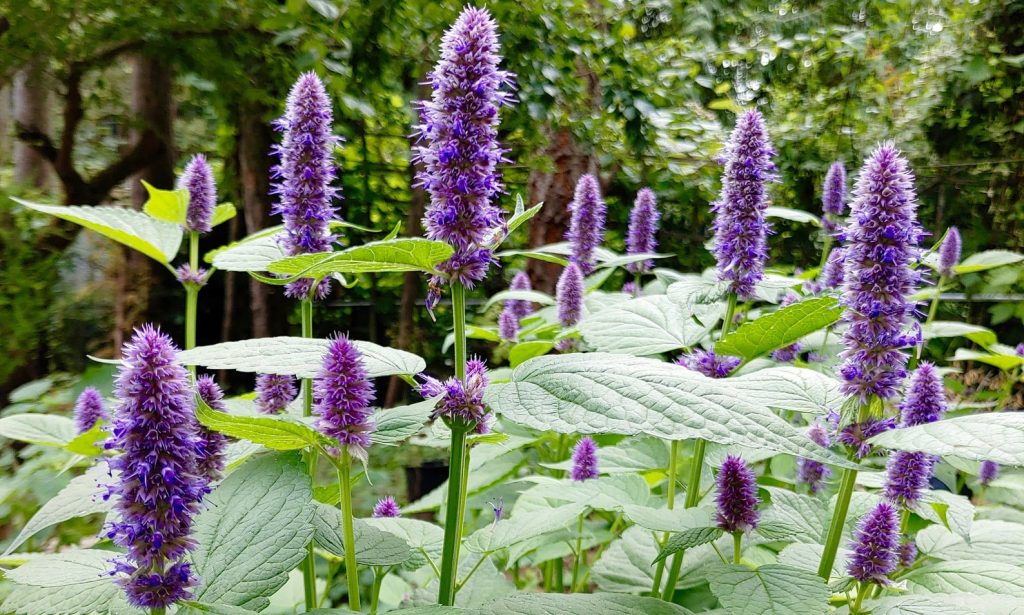
Agastache, also known as “hummingbird mints” and “Giant hyssops,” are aromatic herbaceous perennials, with around 22 species native to North America. These plants are highly appealing to hummingbirds due to their distinctive appearance. The flowers, which grow in clusters, are approximately 3 to 4 inches long and appear fuzzy. With striking purple and red colors, they become irresistible to hummingbirds during the summer when they are in full bloom.
To cultivate Agastache flowers successfully, start them as indoor plants in May and subsequently transplant them into flower beds during the summer. They require full sun and regular watering during their establishment phase. However, once they have acclimated, they become drought-tolerant and can thrive with minimal intervention. These desert plants can withstand scorching days, eliminating the need for excessive watering. Overwatering may lead to root rot, so it is advisable to provide them with a modest amount of water and allow them to dry naturally.
Common Name: Agastache, Hummingbird Mint, and Hyssop
Scientific Name: Agastache
Growing Zones: 3 – 10
Sun: Full sun
Soil: Lean soil, well-draining
Colors: Blue, purple, red, orange, pink, white
Height: 3 to 5 feet tall
Spread: Varies
Plant Type: Herbaceous perennial
4. Vibrant Climbers – Morning Glory
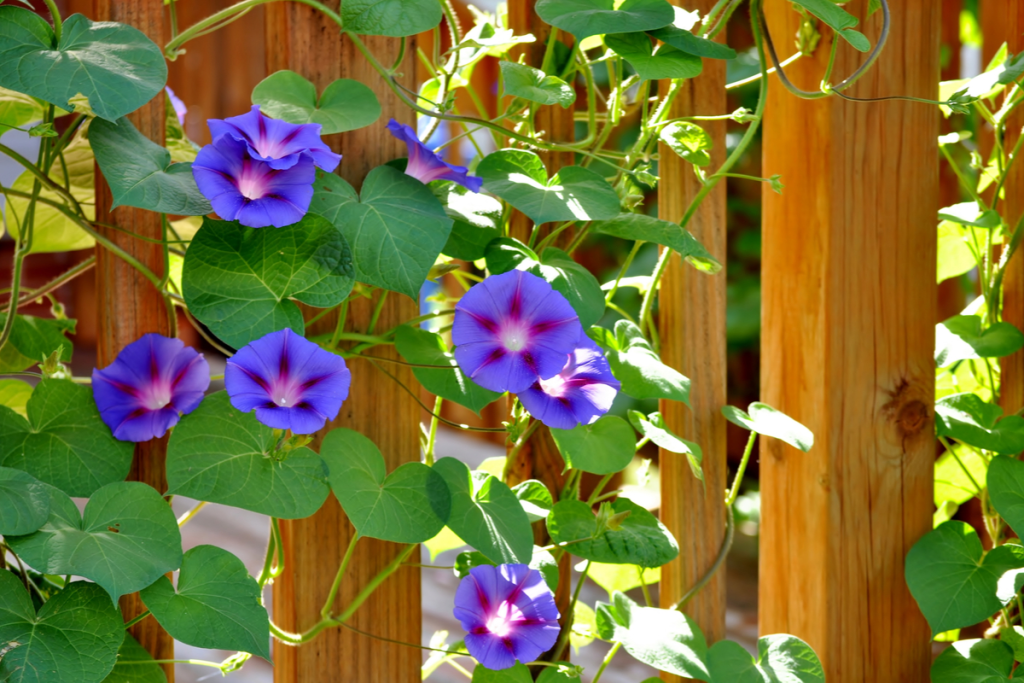
The term “Morning Glory” encompasses over 1,000 species of flowering plants belonging to the Convolvulaceae family. These plants earned their name because their flowers unfurl early in the morning and close during the heat of the day. While most Morning Glory species exhibit this behavior, there are exceptions such as Ipomoea alba, which blooms at night.
Morning glory flowers are characterized by their bright and colorful blooms, rapid vine growth, vibrant green foliage, and tolerance for poor and dry soils. They are often grown around arbors or allowed to climb along the exterior walls of houses using a trellis.
One well-known Morning Glory species that attracts hummingbirds is Ipomoea purpurea. It features bright purple, trumpet-shaped flowers and heart-shaped leaves that open in the morning and close in the afternoon. These flowers bloom from early summer to early fall.
Although Morning Glory is an annual vine, it may exhibit perennial characteristics in milder climates. For optimal blooming, they require full sun exposure, ideally around 8 hours of sunlight each day.
It is essential to manage the fast-growing vines of Morning Glory to prevent them from becoming invasive. Moreover, their seeds are toxic if consumed, so it is crucial to keep children and pets away from these plants.
Common Name: Morning Glory, Common Morning Glory
Scientific Name: Convolvulaceae family
Growing Zones: 2 – 11
Sun: Full sun
Soil: Moist, well-draining
Colors: White, pink, purple, blue
Height: 6 – 10 feet tall
Spread: 3 – 6 feet wide
Plant Type: Annual
5. Shade-Loving Annuals – Impatiens
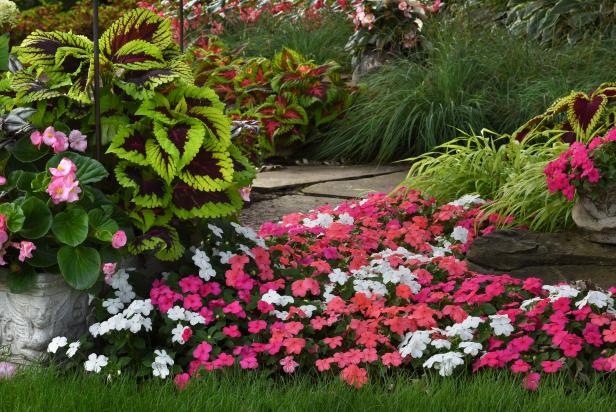
Bright and colorful annuals like Impatiens can effectively bring life to dark and
shady areas while attracting hummingbirds. These plants thrive in moist, well-draining soil and prefer deep shade. Hanging them on your porch can provide a suitable environment for their growth.
Typically, Impatiens are grown from plants purchased in trays at nurseries. Plant them close together to create a dense mat of flowers and leaves. Seeds can also be collected from mature plants and sown indoors 10 weeks before the last frost, as they require ample time to flower. Alternatively, cuttings can be taken in the fall and grown indoors until the frost has passed.
Common Name: Impatiens, Jewelweed, Touch-me-not, Snapweed, Patience
Scientific Name: Impatiens
Growing Zones: 2 – 11
Sun: Shade or partial shade
Soil: Rich, well-draining
Colors: Red, pink, purple, yellow, coral
Height: 6 – 36 inches
Spread: 1 – 3 feet
Plant Type: Annual
6. Columbine
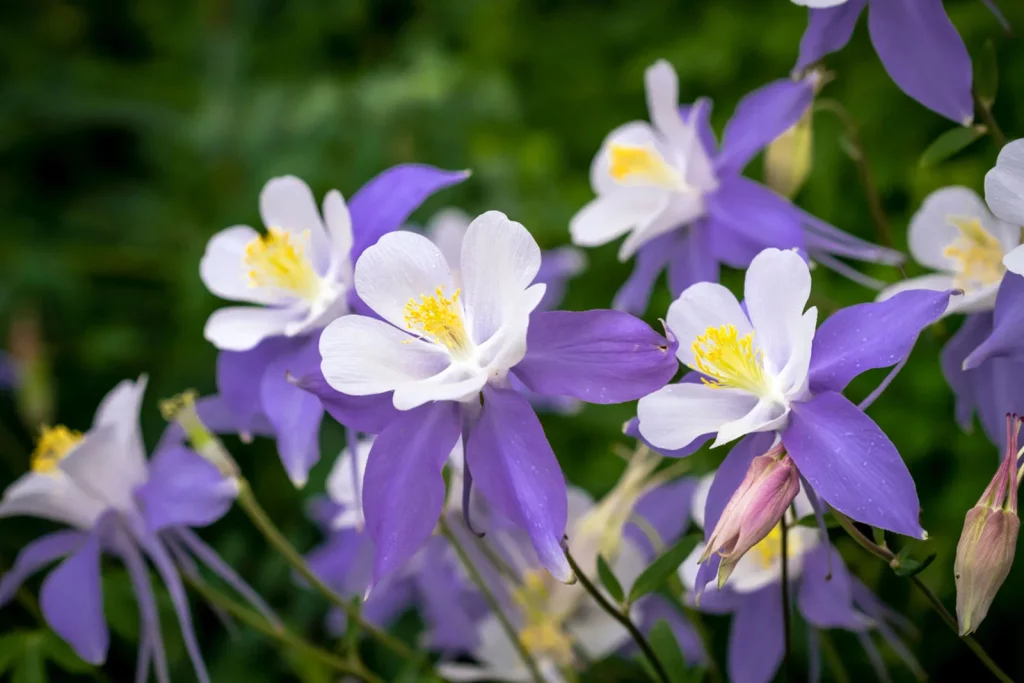
To attract hummingbirds, you can rely on the captivating charm of columbine flowers. With their vibrant array of colors, these plants thrive in areas with partial shade.
Columbine, scientifically known as Aquilegia, exhibits an elegant allure as a perennial plant, boasting spiky bell-shaped blooms that measure between 3 to 6 inches in length.
With various columbine varieties available, most prefer to bask in the sun while tolerating full shade, making them an excellent choice for attracting hummingbirds, especially during the early spring season.
Not only are these versatile flowers shade-tolerant, but they are also drought-resistant and can withstand deer encounters.
For optimal growth, sow columbine seeds directly into the ground during springtime. Once the flowering season concludes, leaving the seeds to self-seed will perpetuate their presence. Alternatively, you can sow the seeds indoors 6 to 8 weeks prior to the last frost date. Keep in mind that flowers may not appear until the second year for seed-grown plants.
Common Name: Columbine, Aquilegia
Scientific Name: Aquilegia
Growing Zones: 3-9
Sun: Full sun to partial shade
Soil: Neutral PH, moist but not wet soil
Colors: Red, Pink, Blue, Orange, White, Yellow
Height: 1 – 3 feet
Spread: 1 foot
Plant Type: Perennial
7. Coneflower
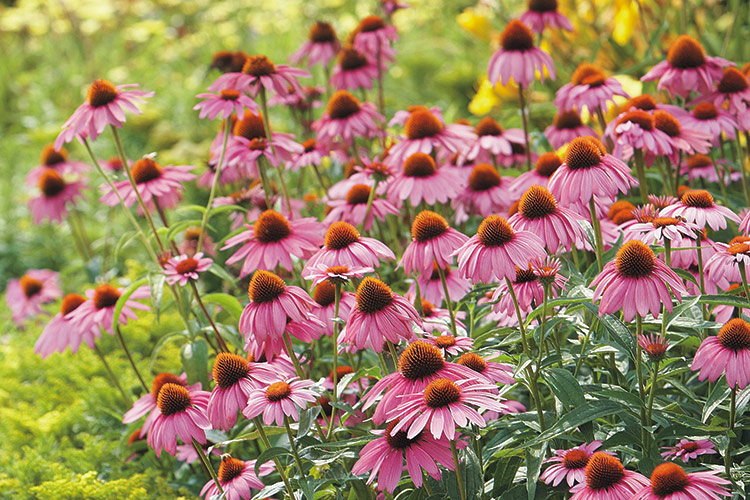
Within the daisy family, Asteraceae, resides coneflower, scientifically known as Echinacea. This genus includes ten different species, with their petals curving downward upon the opening of the central flower head, resembling a cone. One prominent example is Echinacea purpurea, or the purple coneflower, which flourishes in the eastern regions of North America.
Coneflowers captivate onlookers with their sizable blooms, measuring approximately 6 inches in diameter. Rising on stalks that reach up to 5 feet in height, they showcase an array of vibrant colors, including pink, red, orange, yellow, and white, depending on the specific variety. These plants thrive in full sun and prefer well-drained soil conditions. Throughout the summer and well into fall, these cheerful flowers adorn gardens, captivating the attention of hummingbirds, bees, and butterflies.
The nectar-rich central cones of coneflowers entice hummingbirds, as their bright hues, particularly reds and purples, hold an irresistible allure. Their tubular structure ensures a plentiful supply of nectar.
Ensure coneflowers are provided ample sunlight for optimal growth, as they flourish and maintain upright stems when provided with sufficient shade. Lean, nutrient-poor soil with moderate moisture levels suits them best. Although they can tolerate drought, occasional watering is recommended. Selecting a variety suited to your soil conditions and climate will contribute to their longevity.
Common Name: Coneflower
Scientific Name: Echinacea
Growing Zones: 3 – 9
Sun: Full Sun
Soil: Varies
Colors: White, Yellow, Orange, Pink, Red, Purple, Green
Height: 2 to 5 feet tall
Spread: 1 ½ – 2 feet wide
Plant Type: Perennial
8. Penstemon
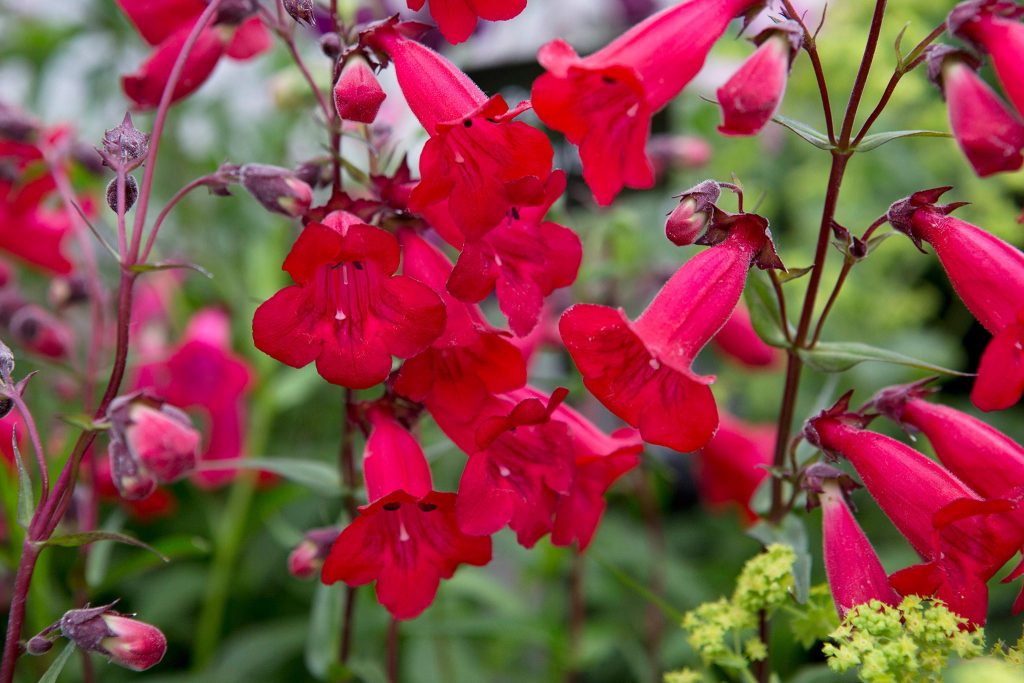
Penstemon, a genus comprising over 250 ornamental flowering plants, belongs to the Plantaginaceae family, similar to snapdragons and foxgloves. Affectionately referred to as “Beardtongue,” these plants feature stamens protruding from their flowers, adorned with tufts of small hairs.
With an extensive range of species and varieties, Penstemon offers a diverse selection to suit every garden. Notable for
their drought tolerance, ability to attract hummingbirds and bees, and ease of care, these beautiful blooms effortlessly elevate any outdoor space.
Penstemon flowers grace gardens in early summer, captivating onlookers with their spires and clusters of colorful tubular blossoms. Varieties span the color spectrum, boasting shades of blue, purple, red, orange, white, pink, and yellow.
Hummingbirds are irresistibly drawn to Penstemon flowers, enticed by their vivid colors and nectar-rich composition.
To ensure optimal growth, plant Penstemon in sun-soaked areas, enabling profuse blooming and preventing stem drooping caused by excessive shade. These plants prefer lean, well-draining soil and are relatively drought-tolerant once established. However, a periodic deep watering can provide added sustenance. Choosing a variety suitable for your specific soil and climate conditions will maximize their longevity.
Common Name: Penstemon, Foxglove Beard-tongue, Talus Slope Penstemon, White Beardtongue
Scientific Name: Penstemon
Growing Zones: 3 – 9
Sun: Full sun
Soil: Lean, fast-draining soil
Colors: Blue, Purple, Red, Orange, White, Pink, Yellow
Height: 6 to 12 inches, 1 to 3 feet, 3 to 8 feet
Spread: 8 to 20 inches
Plant Type: Perennial
9. Summersweet
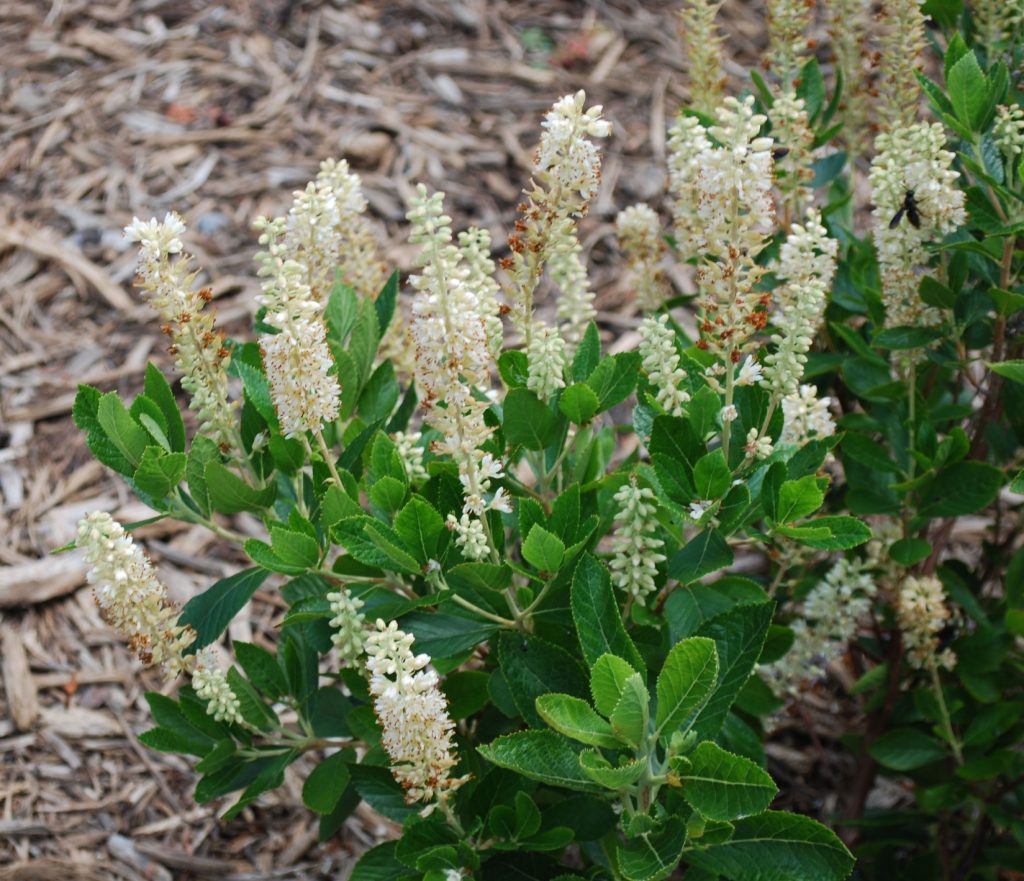
Summersweet, scientifically referred to as Clethra alnifolia, is an exquisite flowering shrub that not only adds visual appeal to your yard but also attracts hummingbirds.
Native to eastern North America, this flowering plant belongs to the Clethraceae family and thrives in various environments, particularly wetlands and the edges of ponds and streams.
Summersweet enchants with vertical spikes of fragrant white flowers amidst its lush, dark green foliage. During autumn, its leaves transition to hues of yellow or gold. Adding to its allure, brown seed capsules resembling peppercorns adorn the plant after flowering.
Flowering occurs between July and August, showcasing 2 to 6-inch-long blossoms in white or pink. Their delightful fragrance serves as a beacon, attracting butterflies, hummingbirds, and other pollinators. During autumn, the pepper-like seeds entice birds.
As a coastal flower, Summersweet thrives in moist to wet soil, ideally in shady conditions. Surprisingly, these flowers bloom more abundantly when provided with shade rather than excessive sunlight. While Summersweet exhibits a tolerance for salty air, maintaining appropriate soil moisture is crucial. To maintain this shrub’s ideal shape, ample space during planting is recommended, as it can spread widely. Maintain soil moisture and prune old branches during spring to encourage new growth and shape refinement.
Common Name: Summersweet, Coastal Sweet Pepperbush
Scientific Name: Clethra alnifolia
Growing Zones: 3 – 9
Sun: Full sun or partial shade
Soil: Moist to wet soil, slightly acidic
Colors: White, Pink, Rose-colored
Height: 4 – 8 feet tall
Spread: 4 – 6 feet wide
Plant Type: Perennial, Deciduous shrub
10. Yarrow
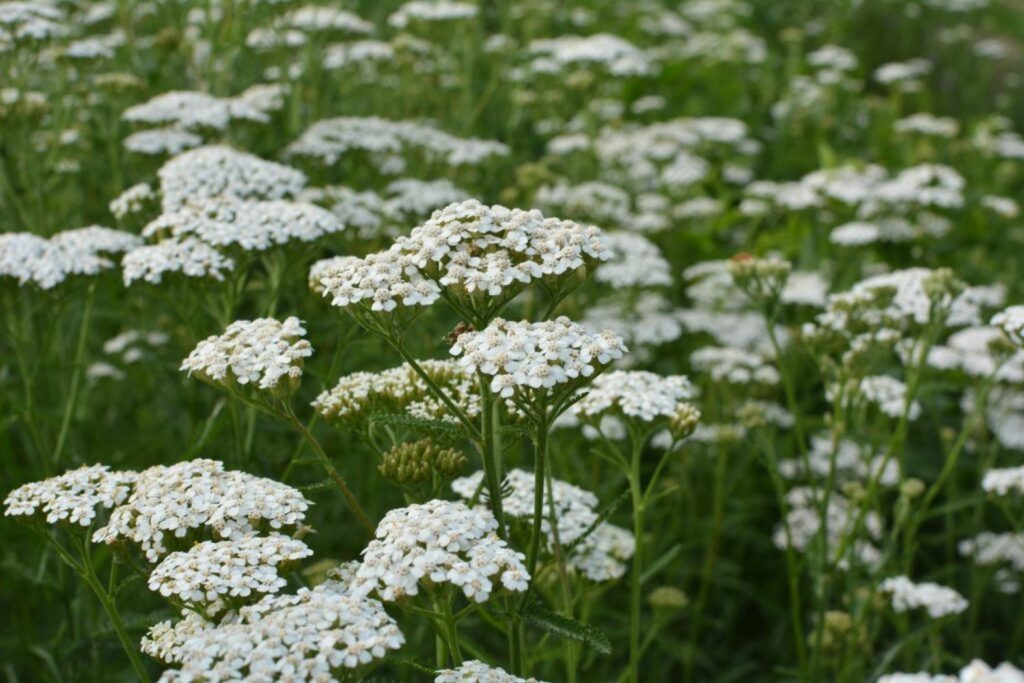
Yarrow, scientifically known as Achillea millefolium, carries a rich history and folklore. Its name originates from the Greek hero Achilles, who was believed to have used yarrow for medicinal purposes. Its leaves were used as a treatment for wounds and respiratory ailments, while its feathery appearance led to its name “millefolium,” meaning “thousand leaves.”
Contrary to its name, yarrow is not a true lily but a flowering plant from the Asphodelaceae family. It grows from fleshy roots rather than bulbs and produces clusters of small, brightly colored flowers in shades of white, yellow, pink, or red, depending on the variety. These flowers form on leafless stems known as “scapes,” which can bear up to 12-15 buds. Mature yarrow plants often have multiple scapes, resulting in abundant blooms throughout the seasons.
While individual yarrow flowers only last for a day, the continuous growth of new flowers ensures a prolonged display from mid-spring to fall.
To encourage optimal blooming, yarrow thrives in areas that receive at least six hours of sunlight daily. Although drought-tolerant, regular watering is necessary, especially during the formation of scapes and buds. Hummingbirds are drawn to the tubular varieties of yarrow, which provide a plentiful source of nectar.
Beyond its ornamental value, yarrow holds medicinal properties and has been used to alleviate various ailments such as wounds, burns, colds, fevers, and headaches.
Common Name: Yarrow
Scientific Name: Achillea millefolium
Growing Zones: 4 – 9
Sun: Full sun
Soil: Sandy, loamy, clay, well-draining
Colors: White, Yellow, Pink, Red
Height: 2 to 3 feet tall
Spread: 2 to 3 feet wide
Plant Type: Perennial
11. Butterfly Weed
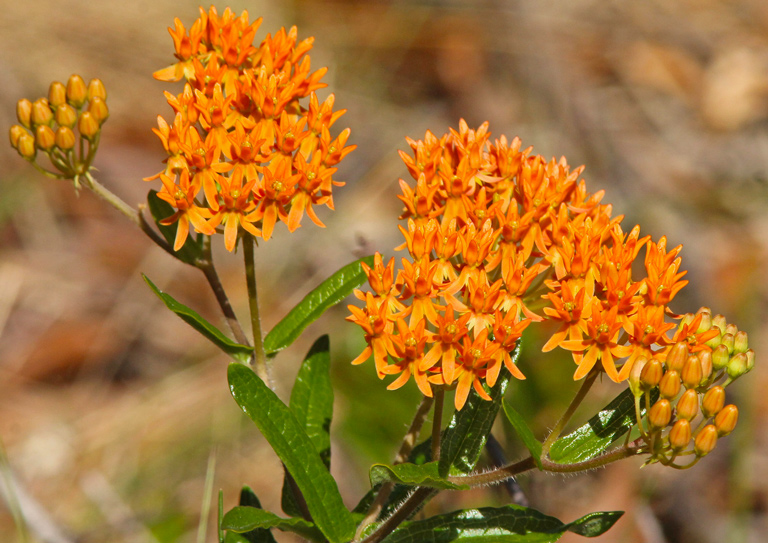
Butterfly weed, scientifically known as Asclepias tuberosa, is a captivating bushy plant renowned for its ability to attract hummingbirds to your garden.
Also referred to as Pleurisy Root, this flowering plant derived its name from its historical use in Native American medicine for treating pleurisy and other respiratory conditions. Additionally, it is often called Orange Milkweed due to its vibrant orange flowers, despite not possessing the milky sap typical of milkweed plants.
Butterfly weed boasts stunning, nectar-filled flowers that form clusters atop its thick, hairy stems, surrounded by lush, bright green foliage.
These beautiful blooms grace gardens from late spring to summer, and their seed pods can be removed to prevent self-seeding if desired.
While butterfly weed requires patience, taking up to three years to flower, it thrives in areas that receive full sunlight. Once established, it exhibits relative drought tolerance, making regular watering unnecessary.
Planting butterfly weed not only enhances the beauty of your garden but also plays a crucial role in the preservation of monarch butterflies. The leaves of the milkweed family serve as a vital food source for monarch caterpillars, contributing to their survival.
Common Name: Butterfly Weed, Coastal Sweet Pepperbush
Scientific Name: Asclepias tuberosa
Growing Zones: 3 – 9
Sun: Full sun
Soil: Poor, dry, well-drained soil
Colors: Orange, Yellow, Red
Height: 1 to 2 feet tall
Spread: 12 to 18 inches wide
Plant Type: Perennial, Deciduous shrub
12. Hydrangea

Hydrangeas, with their enormous flower heads, serve as enchanting additions to shaded areas in your yard. These showy plants thrive in cooler
conditions and prefer partial shade, especially during the heat of the afternoon.
Moist soil is crucial for hydrangeas, and they benefit from a generous watering once a week, particularly in dry weather. Pruning can be conducted in winter once the flowers have withered.
Hydrangea flowers offer an extended display, blooming from spring until well into fall and adding interest even during the winter months.
Common Name: Hydrangea
Scientific Name: Hydrangea
Growing Zones: 3 – 9
Sun: Full sun to shade
Soil: Fertile, well-draining
Colors: Pink, Red, White, Blue, Green
Height: 3 – 15 feet
Spread: 2 – 12 feet
Plant Type: Perennial
13. Daylily
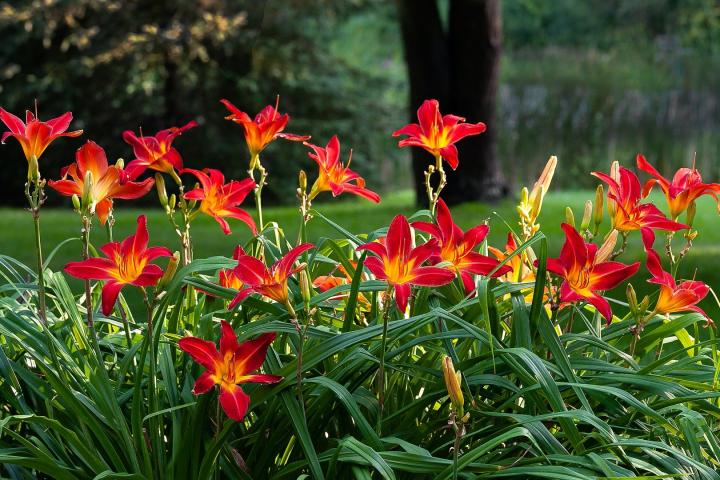
Daylilies, belonging to the Hemerocallis genus, are perennial plants cherished by gardeners for their captivating flowers. With over 35,000 cultivars, daylilies come in a multitude of colors, exhibiting varying plant hardiness, disease resistance, and sturdiness.
Although not true lilies, daylilies share their name due to their day-long blooming cycle. These flowers emerge from fleshy roots rather than bulbs, and each mature daylily plant can produce 4 to 6 leafless stems, known as scapes, adorned with clusters of blossoms.
While individual daylily flowers last only a day, the continuous growth of new flowers ensures abundant blooms throughout the seasons, from mid-spring to fall.
To achieve optimal growth and blooming, daylilies should be planted in areas that receive at least six hours of sunlight daily. Although drought-tolerant, regular watering is essential during the formation of scapes and buds.
Hummingbirds are particularly drawn to the bright-colored daylilies, especially the red and purple varieties. The tubular flowers provide an abundant source of nectar, further attracting these graceful creatures.
Apart from their ornamental value, daylilies possess various medicinal properties and have been traditionally used to treat wounds, burns, colds, fevers, and headaches.
Common Name: Daylily
Scientific Name: Hemerocallis genus
Growing Zones: 4 – 9
Sun: Full sun
Soil: Slightly acidic to neutral
Colors: White, Yellow, Orange, Pink, Red, Purple
Height: 3 to 4 feet tall
Spread: 2 to 4 feet wide
Plant Type: Perennial
14. Tulip Tree

The Tulip tree, scientifically known as Liriodendron tulipifera, serves as the North American counterpart to the Chinese Liriodendron chinense genus. Also referred to as the yellow-poplar, this fast-growing and towering tree is renowned as the tallest eastern hardwood tree.
Tulip tree flowers, resplendent in bright yellow, provide a feast for hummingbirds. In spring, these tulip-shaped flowers open, revealing six greenish-yellow petals with a distinctive orange band near the base. The orange band emphasizes the stamens, attracting hummingbirds and other pollinators.
The leaves of the tulip tree are equally delightful, shaped like stars and featuring a smooth, shiny surface. Typically measuring 3 to 6 inches in length, they transition to gold or vibrant yellow during the autumn months. The stems of the leaves exude a pleasant fragrance.
As these beautiful flowers are often located high above, at heights of up to 50 feet or more, they may not be frequently observed. However, pruning can control the size and maintain a smaller tree. Tulip trees thrive in moist, well-draining soil, and although they are not drought-tolerant, they require a
maximum of six hours of sunlight to foster rapid growth.
Common Name: Tulip Tree
Scientific Name: Liriodendron tulipifera
Growing Zones: 4 – 9
Sun: Full sun
Soil: Moist, well-draining soil
Colors: Green-yellow, Orange
Height: 70 to 90 feet
Spread: 40 feet
Plant Type: Perennial, Deciduous tree
15. Bee Balm
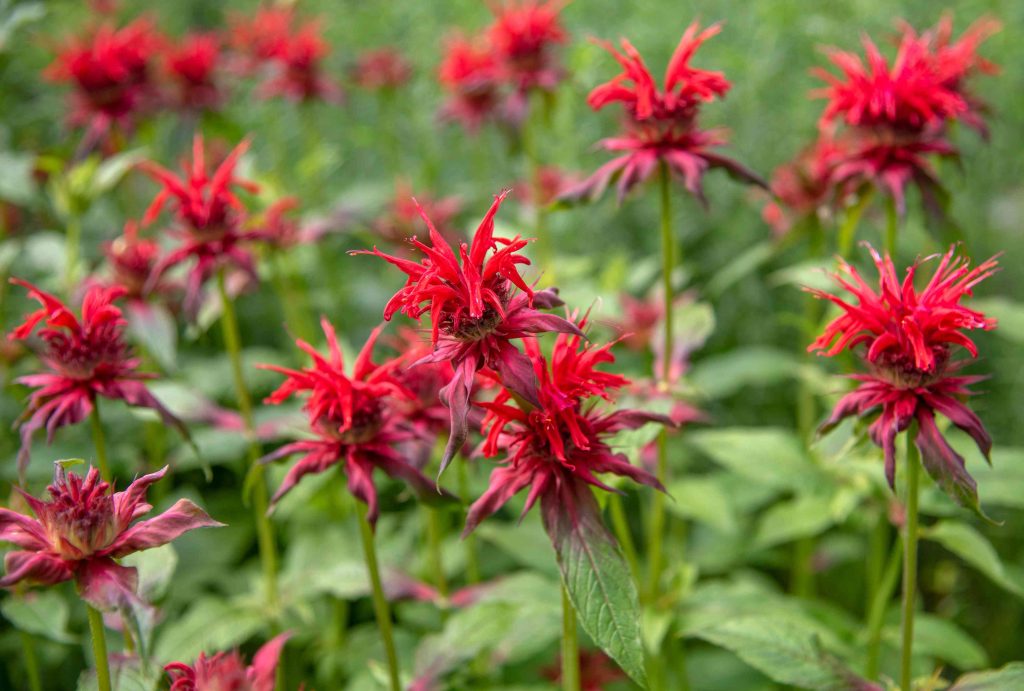
Bee Balm, a member of the Monarda mint family known as Lamiaceae, holds a significant place in history. Native Americans used this plant as an antiseptic salve for treating bee stings, hence its name. It was also referred to as “Oswego Tea” because the Oswego Native Americans brewed its leaves to create tea.
Monarda plants are prized not only for their aromatic leaves but also for their eye-catching, vibrantly colored flowers. Hummingbirds are irresistibly drawn to the scarlet-red variants, such as Monarda didyma. These bright-red, tubular flowers bloom from mid-summer to early fall.
Bee Balm flourishes in full sun but can tolerate partial shade during periods of intense heat. It prefers moist, well-draining soil, making regular watering necessary depending on the climate.
In addition to enhancing the aesthetics of your garden, planting Bee Balm offers several benefits. Its fragrant leaves can be used in salads or brewed for tea. The long-lasting, brilliant flowers serve as a colorful focal point in your backyard, attracting not only hummingbirds but also other pollinators. Moreover, the leaves can be used to create essential oils with medicinal properties.
Common Name: Bee Balm, Bergamot, Horsemint, Oswego Tea
Scientific Name: Monarda from the Lamiaceae family
Growing Zones: 4 – 9
Sun: Full sun, partial shade
Soil: Rich, moist, well-draining
Colors: White, Pink, Red, Purple
Height: 2 – 4 feet tall
Spread: 2 – 3 feet wide
Plant Type: Perennial
16. Salvia
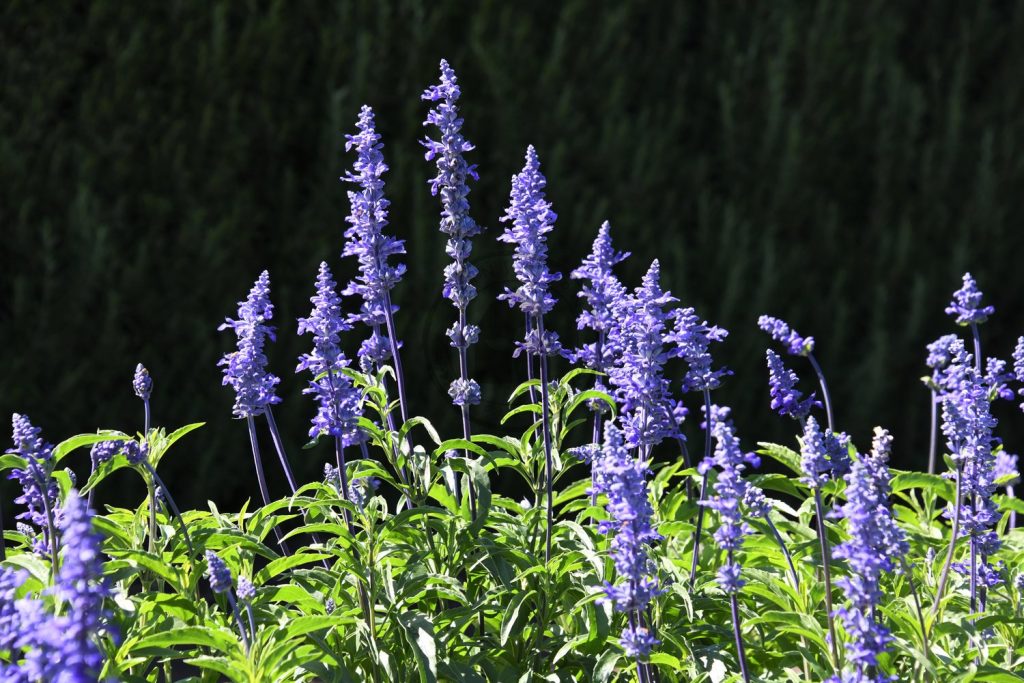
Salvia, also known as sage, is a diverse genus of flowering plants that belongs to the mint family, Lamiaceae. With over 900 species, Salvia offers an array of options to attract hummingbirds to your garden.
These herbaceous perennials are cherished for their vibrant flowers, which come in various colors, including shades of blue, purple, red, and pink. The tubular shape of the flowers makes them particularly enticing to hummingbirds seeking nectar.
Salvia plants are well-adapted to different growing conditions. They thrive in full sun to partial shade and require well-drained soil. Once established, they exhibit drought tolerance, making them suitable for various climates.
Planting Salvia in your garden not only adds a splash of color but also provides a haven for hummingbirds and other pollinators. As they visit the flowers in search of nectar, these delightful creatures contribute to the pollination process, supporting the overall health of your garden ecosystem.
Common Name: Salvia, Sage
Scientific Name: Salvia
Growing Zones: Varies by species
Sun: Full sun to partial shade
Soil: Well-drained
Colors: Blue, Purple, Red, Pink, and more
Height: Varies by species
Spread: Varies by species
Plant Type: Herbaceous perennial
17. Cardinal Flower

The Cardinal flower, scientifically known as Lobelia cardinalis, is a stunning perennial that captivates with its vibrant red flowers. This native wildflower is named after the bright red plumage of the cardinal bird.
Cardinal flowers bloom in late summer, producing tall spikes adorned with numerous tubular flowers. The intense red coloration, combined with the nectar-rich blooms, makes them irresistible to hummingbirds.
To cultivate Cardinal flowers, provide them with a moist environment and partial shade. They thrive in damp soil, making them an excellent choice for rain gardens, near ponds, or in areas with consistent moisture. These flowers are also tolerant of clay soils.
By planting Cardinal flowers in your garden, you not only attract hummingbirds but also contribute to the conservation of native flora. These vibrant beauties provide a source of nectar for these graceful birds, ensuring their sustenance and promoting biodiversity.
Common Name: Cardinal Flower
Scientific Name: Lobelia cardinalis
Growing Zones: 3 – 9
Sun: Partial shade
Soil: Moist, well-drained, clay-tolerant
Colors: Red
Height: 2 – 4 feet tall
Spread: 1 – 2 feet wide
Plant Type: Perennial
18. Trumpet Vine

Trumpet Vine, scientifically known as Campsis radicans, is a vigorous, deciduous woody vine that boasts clusters of trumpet-shaped flowers. These vibrant flowers, available in shades of red, orange, and yellow, provide an irresistible lure for hummingbirds.
The Trumpet Vine’s trumpet-shaped blooms, coupled with their copious nectar supply, make them ideal for attracting these delightful birds. The long, tubular flowers act as a natural feeding station, allowing hummingbirds to extract the sweet nectar they crave.
When planting Trumpet Vines, select a sturdy support structure, as they can grow vigorously and reach considerable heights. These vines require full sun to thrive and prefer well-drained soil. Once established, they display drought tolerance.
Adding Trumpet Vines to your garden not only creates a visually stunning display but also ensures a continuous visit from hummingbirds. As these charismatic birds dart from flower to flower, their presence adds an enchanting touch to your outdoor space.
Common Name: Trumpet Vine
Scientific Name: Campsis radicans
Growing Zones: 4 – 9
Sun: Full sun
Soil: Well
-drained
Colors: Red, Orange, Yellow
Height: Climbing vine, up to 30 feet
Spread: Climbing vine
Plant Type: Deciduous vine
19. Coral Honeysuckle

Coral Honeysuckle, scientifically known as Lonicera sempervirens, is a twining vine native to the United States. With its vibrant tubular flowers and abundant nectar, it serves as a favorite food source for hummingbirds.
This deciduous vine boasts clusters of trumpet-shaped flowers in shades of coral, pink, or orange. As hummingbirds visit these nectar-rich blooms, their long beaks perfectly match the tubular shape, allowing them to access the sweet reward within.
Coral Honeysuckle thrives in full sun to partial shade and is adaptable to various soil types, including sandy or loamy soils. These vines are generally low maintenance and exhibit good drought tolerance once established.
By introducing Coral Honeysuckle to your garden, you provide a welcoming habitat for hummingbirds. As they flit from flower to flower, their presence adds a lively and captivating touch to your outdoor space.
Common Name: Coral Honeysuckle
Scientific Name: Lonicera sempervirens
Growing Zones: 4 – 9
Sun: Full sun to partial shade
Soil: Adaptable
Colors: Coral, Pink, Orange
Height: Climbing vine, up to 20 feet
Spread: Climbing vine
Plant Type: Deciduous vine
20. Red Hot Poker

Red Hot Poker, scientifically known as Kniphofia, is a striking perennial plant that features torch-like flower spikes in vibrant shades of red, orange, and yellow. These unique blooms, resembling pokers or torches, are highly attractive to hummingbirds.
The tubular flowers of Red Hot Poker produce copious amounts of nectar, making them a sought-after food source for hummingbirds. The vibrant colors and upright growth habit of the flower spikes make them easily visible to these agile birds.
Red Hot Poker thrives in full sun and requires well-drained soil. They are relatively drought tolerant once established, making them suitable for xeriscaping or water-wise gardening.
By incorporating Red Hot Poker into your garden, you not only create a visually striking display but also provide a reliable food source for hummingbirds. These charming visitors will be drawn to the vibrant flowers, adding an element of enchantment to your outdoor space.
Common Name: Red Hot Poker, Torch Lily
Scientific Name: Kniphofia
Growing Zones: 5 – 9
Sun: Full sun
Soil: Well-drained
Colors: Red, Orange, Yellow
Height: 2 – 5 feet tall
Spread: 1 – 3 feet wide
Plant Type: Perennial
21. Bee Balm
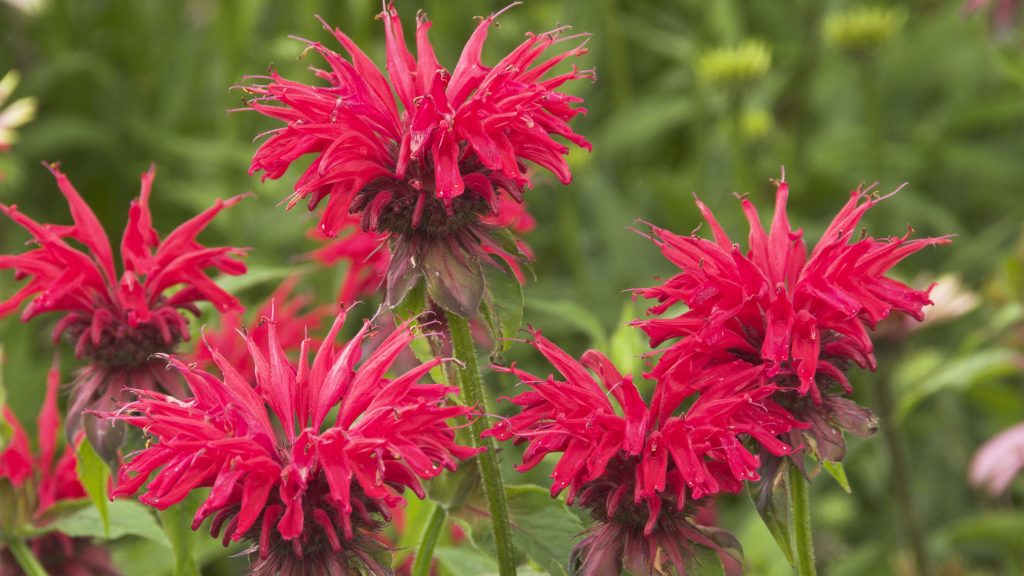
Bee Balm, scientifically known as Monarda, is a beautiful perennial flower that is highly attractive to both hummingbirds and bees. With its vibrant and showy blooms, Bee Balm adds a burst of color to any garden.
The tubular flowers of Bee Balm come in a range of colors, including shades of red, pink, purple, and white. These nectar-rich flowers are irresistible to hummingbirds, who are drawn to their sweet reward.
Bee Balm prefers full sun to partial shade and well-drained soil. It is a low-maintenance plant that can tolerate dry conditions once established.
By planting Bee Balm in your garden, you not only create a visually stunning display but also provide a valuable food source for hummingbirds. The lively presence of these delightful birds adds a touch of enchantment to your outdoor space.
Common Name: Bee Balm
Scientific Name: Monarda
Growing Zones: Varies by species
Sun: Full sun to partial shade
Soil: Well-drained
Colors: Red, Pink, Purple, White
Height: Varies by species
Spread: Varies by species
Plant Type: Perennial
22. Bleeding Heart
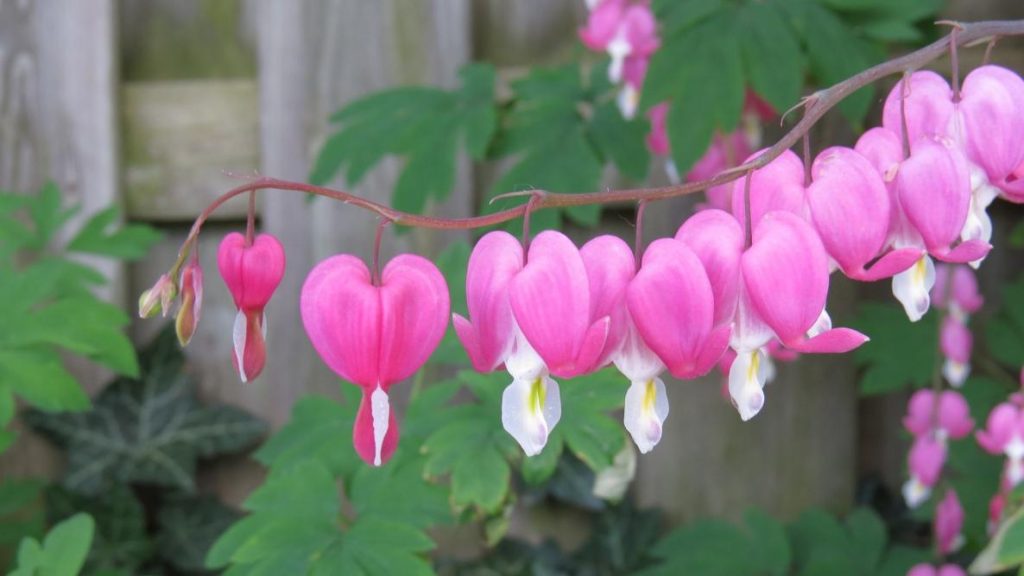
Bleeding Heart, scientifically known as Lamprocapnos spectabilis, is a unique and elegant perennial flower that captures attention with its heart-shaped flowers and delicate appearance. While not specifically known for attracting hummingbirds, these flowers can occasionally be visited by them.
The distinct heart-shaped blooms of Bleeding Heart hang gracefully from arching stems, creating a captivating display. They are typically pink or white in color and add a touch of charm to any garden.
Bleeding Heart thrives in partial shade and moist, well-drained soil. It prefers cool climates and may go dormant during hot summer months.
Although hummingbirds may not be the primary visitors to Bleeding Heart, the unique form and color of the flowers can still attract their attention. By including Bleeding Heart in your garden, you create a serene and enchanting atmosphere that may occasionally entice these delightful birds.
Common Name: Bleeding Heart
Scientific Name: Lamprocapnos spectabilis
Growing Zones: 3 – 9
Sun: Partial shade
Soil: Moist, well-drained
Colors: Pink, White
Height: 1 – 3 feet tall
Spread: 1 – 3 feet wide
Plant Type: Perennial
23. Fuchsia
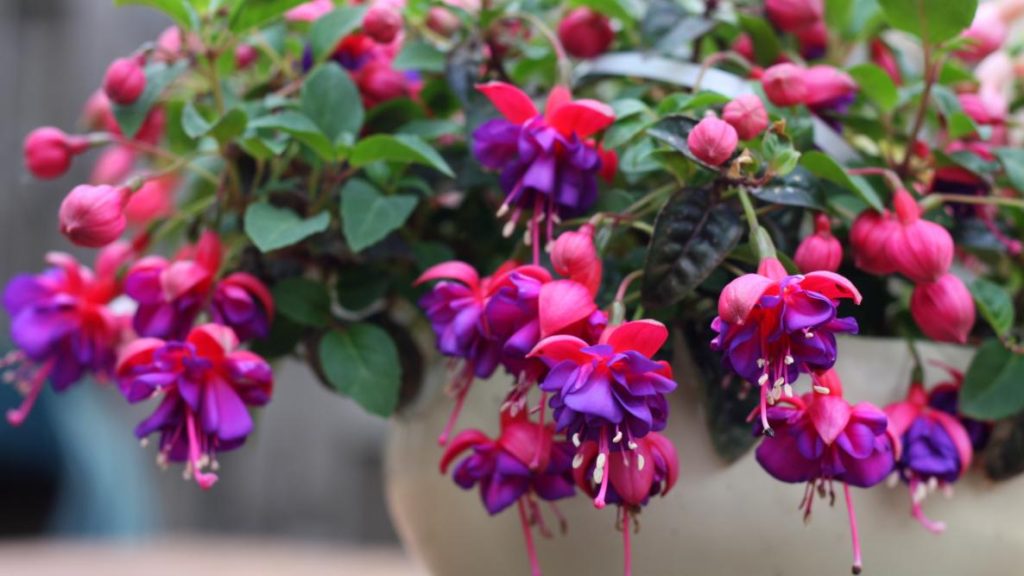
Fuchsia is a stunning flowering plant that is well-known for its elegant and pendulous blooms. While primarily attracting bees and butterflies, certain varieties of Fuchsia can also be visited by hummingbirds.
The intricate flowers of Fuchsia come in various colors, including shades of red, pink, purple, and white. Their unique shape and vibrant hues create a visually striking display in any garden.
Fuchsia thrives in partial shade and well-drained soil. It is important to provide adequate moisture to the plant, as it prefers consistently moist conditions.
While not all varieties of Fuchsia are attractive to hummingbirds, some species with tubular flowers can entice these tiny birds. By incorporating Fuchsia into your garden, you create an eye-catching and dynamic landscape that may occasionally attract hummingbirds.
Common Name: Fuchsia
Scientific Name: Fuchsia
Growing Zones: Varies by species
Sun: Partial shade
Soil: Well-drained
Colors: Red, Pink, Purple, White
Height: Varies by species
Spread: Varies by species
Plant Type: Annual or perennial, depending on the species
24. Cardinal Flower
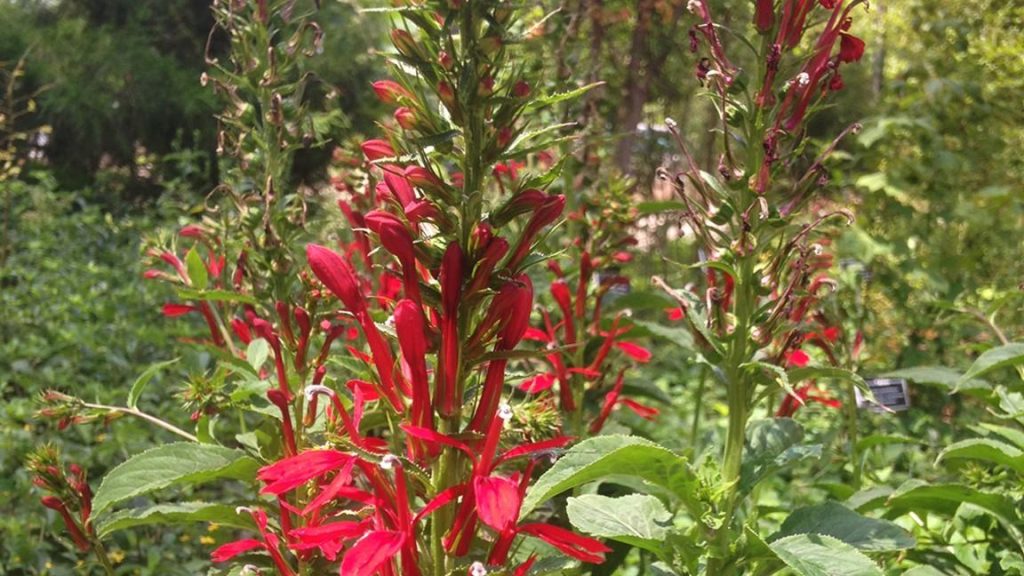
Cardinal Flower, scientifically known as Lobelia cardinalis, is a vibrant and show-stopping perennial plant that is a favorite among hummingbirds. With its striking red flowers, it is highly attractive to these beautiful birds.
The tubular flowers of Cardinal Flower are a brilliant shade of red, resembling the vibrant plumage of a cardinal bird. They grow on tall, erect stems and provide a stunning focal point in any garden.
Cardinal Flower thrives in full sun to partial shade and prefers moist, well-drained soil. It is important to keep the soil consistently moist, as the plant does not tolerate drought well.
By planting Cardinal Flower in your garden, you create a haven for hummingbirds. They will be irresistibly drawn to the rich nectar of the vibrant red flowers, adding a burst of color and liveliness to your outdoor space.
Common Name: Cardinal Flower
Scientific Name: Lobelia cardinalis
Growing Zones: 2 – 9
Sun: Full sun to partial shade
Soil: Moist, well-drained
Colors: Red
Height: 2 – 4 feet tall
Spread: 1 – 2 feet wide
Plant Type: Perennial
25. Trumpet Vine

Trumpet Vine, scientifically known as Campsis radicans, is a vigorous and fast-growing vine that produces stunning trumpet-shaped flowers. These flowers are particularly attractive to hummingbirds, who are drawn to their bright colors and abundant nectar.
The trumpet-shaped flowers of the Trumpet Vine come in shades of red, orange, or yellow, resembling miniature trumpets hanging from the vine. They bloom in clusters and create a striking display.
Trumpet Vine thrives in full sun and well-drained soil. It is a hardy plant that can tolerate various soil conditions, including poor or rocky soil.
By incorporating Trumpet Vine into your garden, you provide a feast for hummingbirds. These agile birds will be enticed by the vibrant and nectar-filled flowers, creating a lively and enchanting atmosphere in your outdoor space.
Common Name: Trumpet Vine
Scientific Name: Campsis radicans
Growing Zones: 4 – 9
Sun: Full sun
Soil: Well-drained
Colors: Red, Orange, Yellow
Height: Climbing vine, up to 30 feet
Spread: Climbing vine
Plant Type: Deciduous vine
26. Salvia
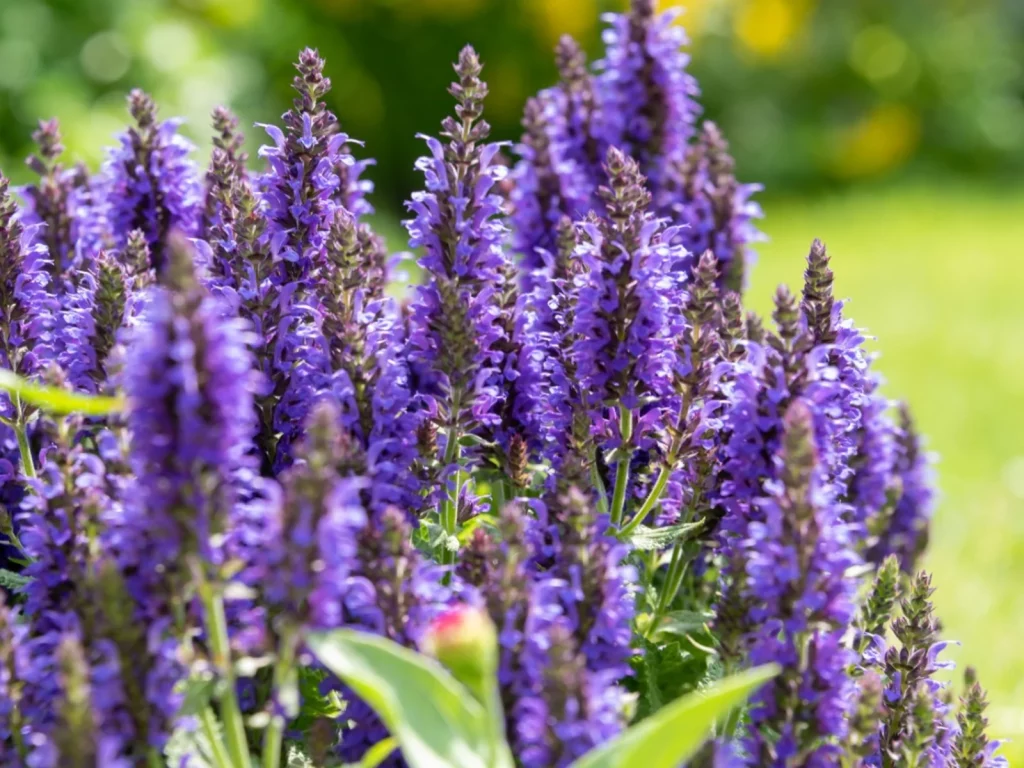
Salvia, also known as sage, is a diverse genus of flowering plants that includes many species attractive to hummingbirds. These plants are known for their vibrant, tubular flowers and aromatic foliage.
Salvia flowers come in a wide range of colors, including shades of red, purple, blue, and pink. The tubular shape of the flowers is well-suited for the long beaks of hummingbirds, making them an irresistible nectar source.
Salvia plants thrive in full sun and well-drained soil. They are relatively low-maintenance and can tolerate dry conditions once established. With their aromatic foliage, they also add a pleasant fragrance to the garden.
By adding Salvia to your garden, you provide a valuable food source for hummingbirds. These birds will be drawn to the abundance of nectar in the tubular flowers, enhancing the beauty and liveliness of your outdoor space.
Common Name: Salvia, Sage
Scientific Name: Salvia
Growing Zones: Varies by species
Sun: Full sun
Soil: Well-drained
Colors: Red, Purple, Blue, Pink, and more
Height: Varies by species
Spread: Varies by species
Plant Type: Perennial or annual, depending on the species
27. Lantana
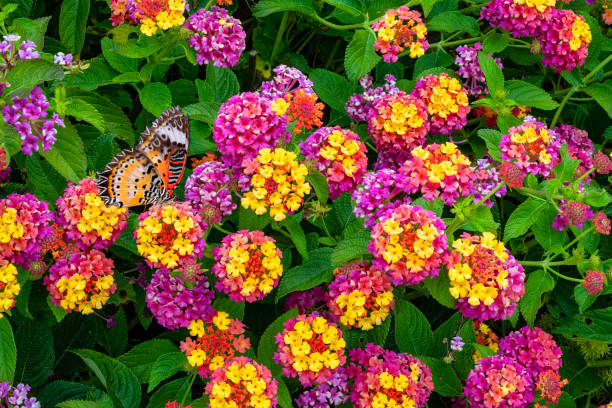
Lantana is a colorful and versatile flowering plant that is highly attractive to hummingbirds. With its vibrant clusters of small, tubular flowers, Lantana provides a delightful feast for these tiny birds.
Lantana flowers are available in a wide range of colors, including shades of red, orange, yellow, pink, and purple. The flowers are arranged in tight clusters, creating a profusion of color and a visual delight.
Lantana thrives in full sun and well-drained soil. It is a hardy plant that can tolerate heat and dry conditions, making it an excellent choice for gardens in hot climates.
By incorporating Lantana into your garden, you create an irresistible feeding station for hummingbirds. They will be drawn to the abundant nectar of the tubular flowers, enhancing the beauty and charm of your outdoor space.
Common Name: Lantana
Scientific Name: Lantana
Growing Zones: Varies by species
Sun: Full sun
Soil: Well-drained
Colors: Red, Orange, Yellow, Pink, Purple, and more
Height: Varies by species
Spread: Varies by species
Plant Type: Perennial or annual, depending on the species
28. Coral Bells
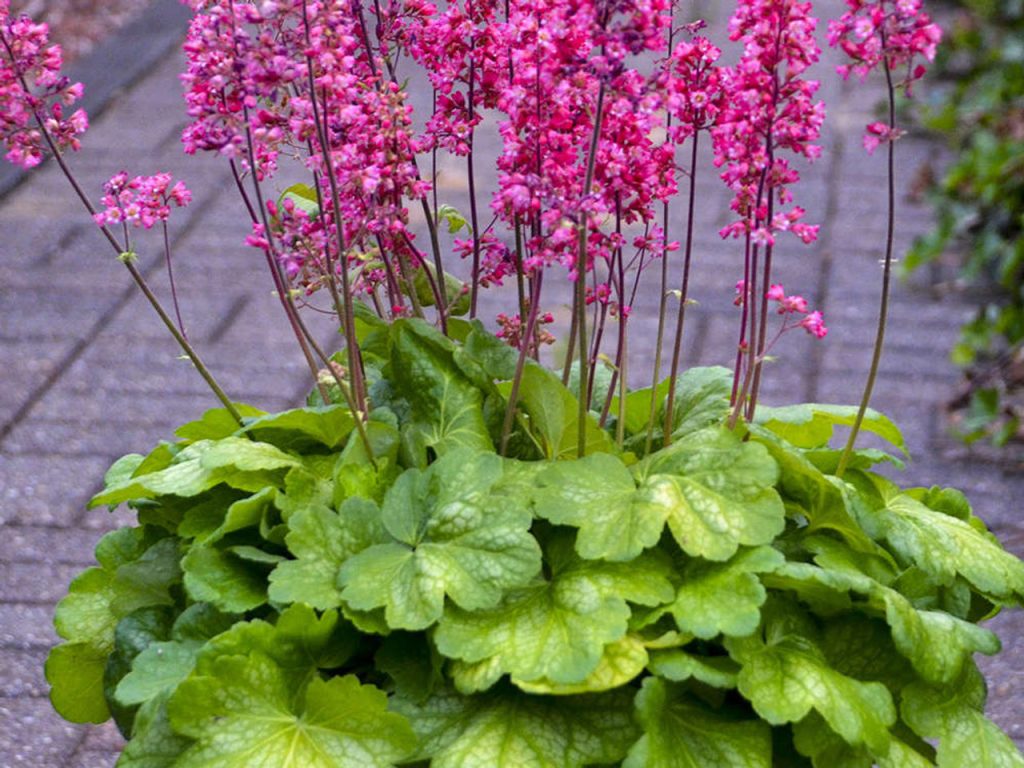
Coral Bells, scientifically known as Heuchera, are a group of perennial plants admired for their unique foliage and delicate flowers. While primarily attracting butterflies, the tiny flowers of Coral Bells can also occasionally entice hummingbirds.
Coral Bells are known for their vibrant and often variegated leaves, which come in shades of green, purple, silver, and bronze. The dainty flowers, held on slender stalks, add a touch of elegance to the overall display.
Coral Bells prefer partial shade to full shade and well-drained soil. They are adaptable plants that can thrive in a range of conditions, from woodland gardens to rockeries.
While not the main attraction for hummingbirds, the delicate flowers of Coral Bells can still capture their attention. By incorporating Coral Bells into your garden, you create a visually captivating and diverse landscape that may occasionally draw these delightful birds.
Common Name: Coral Bells
Scientific Name: Heuchera
Growing Zones: Varies by species
Sun: Partial shade to full shade
Soil: Well-drained
Colors: Varies by species
Height: Varies by species
Spread: Varies by species
Plant Type: Perennial
These are just a few examples of plants that can attract hummingbirds to your garden. By selecting a variety of nectar-rich flowers with vibrant colors, you can create an oasis that will entice these beautiful birds and bring joy and vitality to your outdoor space.